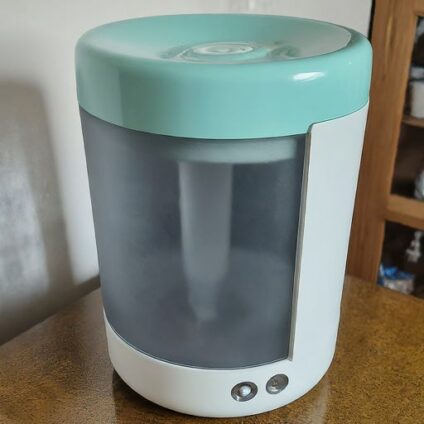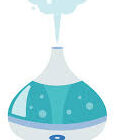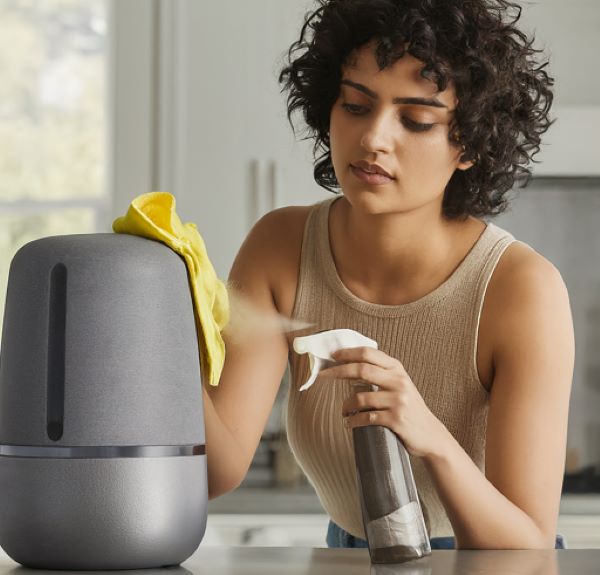Tested and Proven Steps for How To Clean A Humidifier With Water And Soap
The short answer is yes, you can clean a humidifier with soap and warm water.
Do you live in a place that experiences cold and dry winters, and thus find the need to use a humidifier in the winter? This short post is for you!
You see, humidifiers add moisture to dry air, raising the humidity inside the house. It is recommended that you keep the indoor humidity level at 40 to 60% during the cold season.
Using a humidifier gives you comfort, especially when you are sleeping, you know, saving you from the symptoms of sleeping in dry air.
This humidity control device also makes it easier to deal with respiratory issues. However, to keep it functioning in the best way possible, you need to keep it in top-notch condition.
Your mist maker needs regular cleaning to prevent the growth of mold and bacteria that can be harmful if released into the air you breathe.
While specific cleaning methods may vary depending on your humidifier model, soap and water can be an effective and safe cleaning solution in most cases.
So, to answer the question, soap and water is good for cleaning the humidifier, but it is advisable to use mild dish soap and warm water. Do not use soaps that contain harsh chemicals, as they damage the humidifier tank. Also, be gentle; do not scrub the tank with tough materials. Use the cleaning brush that was shipped with the humidifier.

Clean a (cool mist) humidifier with soap and water
Things you’ll need
- Mild dish soap
- Warm water
- White vinegar (optional for stubborn mineral deposits)
- Soft cleaning cloths or sponges
- Soft-bristled brush (optional)
- Distilled water (to refill your humidifier)
- User manual for your specific humidifier model (always consult this first)
Cleaning the humidifier filters
Unplug and disassemble the humidifier – safety first!
Always unplug your humidifier before cleaning. Refer to your user manual for specific instructions on removing the filter(s). Different types of filters require different cleaning methods.
Check the filter type:
Humidifiers come with different filters, as you can see below:
Reusable cloth or foam filters: Rinse under warm water, gently squeezing out any excess dirt. You can use a mild soap if needed. Air-dry completely before replacing.
Disposable humidifier filters: Check the manufacturer’s recommendations. Some may be washable, while others need replacing after a certain period.
For stubborn residue on the filter such as mineral deposits or tough grime, mix equal parts white vinegar and water and soak the filter for 30 minutes. Rinse thoroughly and air-dry completely.
Cleaning the humidifier tank

This is a pretty straightforward process. However, if you have seen signs of pink mold in the humidifier, you might need to focus on killing the fungus too, as well as cleaning the water reservoir.
Step 1: Empty and discard the old water.
Step 2: Fill the tank with warm, soapy water. Use a mild dish soap and avoid harsh chemicals.
Step 3: Swirl and scrub. Gently agitate the water to loosen any residue. You can use a soft sponge or brush to reach harder-to-reach areas. Pay attention to corners and seams where mold may hide, such as the cap area.
Step 4: Rinse thoroughly. Empty the soapy water and rinse the tank under clean, running water until all the soap suds are gone.
Step 5: Vinegar treatment (if you have mold). For stubborn mineral deposits, fill the tank with a diluted vinegar solution (1 part vinegar to 4 parts water) and let it sit for 30 minutes. Rinse thoroughly.
Step 6: Air dry completely. Leave the tank open and upside down on a clean cloth to air dry completely. Never reassemble a damp tank.
Steps for cleaning the humidifier base
Wipe down the exterior: Use a damp cloth with mild soap and water to wipe down the outside of the humidifier base. Avoid getting any water near the electrical components, as this is one of the reasons for a humidifier not working after cleaning.
Remove the mineral deposits: If you see white mineral buildup on the base, use a vinegar-soaked cloth to dissolve it. Rinse with clean water.
Never submerge the base in water or any liquid. Never immerse the base of your humidifier in water, as this can damage electrical components.
How to clean a warm mist humidifier with soap and water
Now, suppose you have a Vicks warm mist humidifier… Definitely, you will need to try a different cleaning method.
I will show you how, starting with the things you will need for the cleaning process itself:
Things you will need:
White vinegar (optional): This acts as a natural disinfectant for stubborn mineral deposits or suspected mold growth.
- Dish soap: Opt for a mild, fragrance-free formula to avoid harsh chemicals.
- Soft cloths or sponges: Gentle on your humidifier’s surfaces.
- Soft-bristled brush (optional): For tackling hard-to-reach areas or stubborn grime.
- Cotton swabs (optional): Useful for cleaning delicate crevices.
- The humidifier manual: Check yours for specific instructions and warnings related to your model.
Step 1: Unplug it, let it cool down
Safety first! Always unplug your humidifier before starting any cleaning.
Empty the water tank
Dispose of the water and rinse the tank with clean water to remove any loose debris. Just empty the water into your kitchen sink.
Locate and remove the filter(s)
Refer to your manual for precise instructions. Most filters are washable, while others require replacement.
Step 2: Cleaning the tank
Fill the tank with warm water and add mild dish soap. Swirl the solution to mix and let it sit for 15 minutes. This loosens dirt and mineral deposits.
Get scrubbing! Use a soft brush or sponge to clean the tank walls and base, paying close attention to corners and crevices where residue tends to accumulate.
Get rid of mineral deposits. For stubborn buildup, soak the tank in a 1:1 mixture of warm water and white vinegar for 30 minutes. Scrub and rinse thoroughly.
Final rinse and dry. Rinse the tank several times with clean water to remove all soap and vinegar residue. Leave the tank open to air-dry completely before refilling.
Step 3: Clean the filter (washable filters only)
Rinse the filter under clean, running water. Hold it under low pressure to avoid damaging the delicate filter material.
Gently squeeze out excess water. Don’t wring or twist the filter, as this can damage its structure.
Optional: Soak in a vinegar solution. If the filter appears heavily soiled, soak it in a 1:1 vinegar and water solution for 30 minutes. Thoroughly rinse afterward.
Air-dry completely. Never use a damp filter in your humidifier. Replace the filter once it is completely dry.
Step 4: Cleaning the base
Focus on the exterior. Use a damp cloth with a mild soap solution to wipe down the base. Avoid immersing the base in water or using harsh chemicals.
Target the mist outlet. Dip a cotton swab in clean water and gently clean the outlet to remove any dust or debris buildup.
Air-dry the base completely. This prevents moisture buildup and potential mold growth.
Step 5: Clean the heating elements
A warm mist humidifier has heating elements that boil the water so that the unit can make a warm mist. This step requires extra caution due to the delicate nature of the heating elements.
Never immerse the base in water! This can damage electrical components.
Locate the heating element area, usually a metal plate or cylinder, inside the base.
Dip a cotton swab in clean water and gently wipe the heating element to remove any visible dust or debris. Do not scrub or apply pressure.
Avoid using soap or vinegar on the heating element. These can leave residue and affect its performance.
Step 5: Reassemble, refill the tank and reattach it
Once everything is completely dry, reassemble your humidifier according to the manual.
Fill the humidifier with distilled water. Avoid using tap water in the humidifier to prevent mineral buildup.
Remember, using water with minerals in an ultrasonic unit will leave humidifier white dust on your surfaces.
Plug it in and power up! Enjoy the clean, healthy mist, knowing your humidifier is functioning at its best.
Frequently Asked Questions
How often should I clean my humidifier?
Clean your humidifier at least once a week, and more frequently if you use it heavily or live in a dry area.
Can I use other cleaning agents besides soap and water?
Avoid harsh chemicals, bleach, or essential oils, as they can damage your humidifier and release harmful fumes. Stick to mild dish soap and white vinegar for safe and effective cleaning.
What type of water should I use in my humidifier?
Distilled water is recommended to prevent mineral buildup. Tap water can contain minerals that leave white dust and clog your humidifier.
What if my humidifier still smells after cleaning?
If you notice a persistent odor after cleaning, it could indicate black mold in the humidifier. In this case, clean the unit again with white vinegar until all traces of mold are gone.
Final thoughts
Maintaining a clean humidifier is crucial for your health and the lifespan of the appliance. And now, you can just use soap and water for the job.
Important things to remember:
Clean your humidifier at least once a week, especially when you use it frequently
Check the user manual for specific humidifier cleaning instructions and warnings for your model.
Never use bleach or harsh chemicals on your humidifier, except in rare cases when you want to kill mold or bacteria. Even then, use the bleach sparingly, and never with white vinegar.
Replace non-washable filters according to the manufacturer’s recommendations.
Store your humidifier properly when it is not in use. Choose a cool, dry place to prevent mold growth. Don’t store a dirty humidifier. Clean it and dry it thoroughly before storage.

